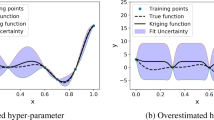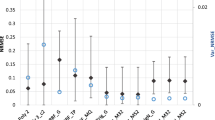Abstract
Metamodeling or surrogate modeling is becoming increasingly popular for product design optimization in manufacture industries. In this paper, an extended Gaussian Kriging method is proposed to improve the prediction performance of widely used ordinary Kriging in engineering design. Unlike the forgoing approaches, the proposed method places a variance-varying Gaussian prior on the unknown regression coefficients in the mean model of Kriging and makes prediction at untried design points based on the principle of Bayesian maximum a posterior. The achieved regression mean model is adaptive, therefore capable of capturing more effectively the overall trend of computer responses and leading to a more accurate metamodel. Particularly, the regression coefficients in the mean model are estimated by a fast numerical algorithm, making extended Gaussian Kriging implemented roughly as efficient as ordinary Kriging. Experiment results on several examples are presented, showing remarkable improvement in prediction using extended Gaussian Kriging over ordinary Kriging and several other metamodeling methods.


Similar content being viewed by others
References
Wang GG, Shan S (2007) Review of metamodeling techniques in support of engineering design optimization. ASME transactions. J Mech Des 45(6):1208–1221
Li R, Sudjianto A (2005) Analysis of computer experiments using penalized likelihood in Gaussian Kriging models. Technometrics 47:111–120
Fang KT, Li R, Sudjianto A (2006) Design and modeling for computer experiments. CRC Press, New York
Santner TJ, Willianms BJ, Notz WI (2003) The design and analysis of computer experiment. Springer, Berlin
Simpson TW, Peplinski J, Koch PN, Allen JK (2001) Metamodels for computer-based engineering design: survey and recommendations. Eng Comput 17(2):129–150
Sacks J, Welch WJ, Mitchell TJ, Wynn HP (1989) Design and analysis of computer experiments. Stat Sci 4(4):409–435
Sacks J, Schiller SB, Welch WJ (1989) Designs for computer experiments. Technometrics 31(1):41–47
Kleijnen JPC (2005) An overview of the design and analysis of simulation experiments for sensitivity analysis. Eur J Oper Res 164(2):287–300
Wackernagel H (2002) Multivariate geostatistics. Springer, New York
Currin C, Mitchell TJ, Morris MD, Ylvisaker D (1991) Bayesian prediction of deterministic functions, with applications to the design and analysis of computer experiments. J Amer Statist Assoc 86:953–963
Welch WJ, Buck RJ, Sacks J, Wynn HP, Mitchell TJ, Morris MD (1992) Screening, predicting, and computer experiments. Technometrics 34:15–25
Simpson TW, Mauery TM, Korte JJ, Mistree F (2001) Kriging metamodels for global approximation in simulation-based multidisciplinary design optimization. AIAA J 39(12):2233–2241
Martin JD, Simpson TW (2004) On using Kriging models as probabilistic models in design. SAE Trans J Mater Manuf 5:129–139
Martin JD, Simpson TW (2005) On the use of Kriging models to approximate deterministic computer models. AIAA J 43:853–863
Giunta AA (1997) Aircraft multidisciplinary design optimization using design of experiments theory and response surface modeling. Dissertation, Virginia Polytechnic and State University, Blacksburg
Booker AJ, Conn AR, Dennis JE, Frank PD, Serafini D, Torczon V, Trosset M (1996) Multi-level design optimization: a Boeing/IBM/Rice collaborative project. The Boeing Company, Seattle
Cappelleri DJ, Frecker MI, Simpson TW, Snyder A (2002) Design of a PZT bimorph actuator using a metamodel-based approach. ASME J Mech Des 124:354–357
Joseph VR, Hung Y, Sudjianto A (2008) Blind Kriging: a new method for developing metamodels. ASME J Mech Des 130: 031102-1-8
Linkletter CD, Bingham D, Hengartner N, Higdon D, Ye KQ (2006) Variable selection for Gaussian process models in computer experiments. Technometrics 48:478–490
Joseph VR (2006) Limit Kriging. Technometrics 48:458–466
Jin R, Chen W, Simpson TW (2001) Comparative studies of metamodeling techniques under multiple modeling criteria. Struct Multidiscip Optim 23(1):1–13
Koehler JR, Owen AB (2003) Computer experiments. In: Ghosh S, Rao CR (eds) Handbook of Statistics. Elsevier Science, New York, pp 261–308
McKay MD, Bechman RJ, Conover WJ (1979) A Comparison of three methods for selecting values of input variables in the analysis of output from a computer code. Technometrics 21(2):239–245
Park JS (1994) Optimal Latin-hypercube designs for computer experiments. J Stat Plan Inference 39:95–111
Fang KT, Lin DKJ, Winker P, Zhang Y (2000) Uniform design: theory and application. Technometrics 39(3):237–248
Kalagnanam JR, Diwekar UM (1997) An efficient sampling technique for off-line quality control. Technometrics 39(3):308–319
Owen A (1992) Orthogonal arrays for computer experiments, integration, and visualization. Statistica Sinica 2:439–452
Hedayat AS, Sloane NJA, Stufken J (1999) Orthogonal arrays: theory and applications. Springer, New York
Simpson TW, Lin DKJ, Chen W (2001) Sampling strategies for computer experiments: design and analysis. Int J Reliab Appl 2(3):209–240
Montgomery DC (2001) Design and analysis of experiments. Wiley, New York
Fang HB, Horstemeyer MF (2006) Global response approximation with radial basis functions. Eng Optim 38(4):407–424
Fang HB, Rais-Rohani M, Horstemeyer MF (2004) Multi-objective crashworthiness optimization with radial basis functions. In: Proceedings of the 10th AIAAISSMO Multidisciplinary Analysis and Optimization Conference, Paper No. AIAA-2004-4487, Albany
Powell MJD (1987) Radial basis functions for multivariate interpolation: a review. In: Mason JC, Cox MG (eds) Algorithm for approximation. Clarendon Press, Oxford, pp 143–167
Hardy RL (1971) Multiquadratic equations of topography and other irregular surfaces. J Geophys 76:1905–1915
Hussain MF, Barton RR, Joshi SB (2002) Metamodeling: radial basis functions, versus polynomials. Eur J Oper Res 138(1):142–154
Krishnamurthy T (2003) Response surface approximation with augmented and compactly supported radial basis functions. In: Proceedings of the 44th AIAAASMEASCEAHSASC Structures, Structural Dynamics, and Materials Conference, Paper No. AIAA-2003-1748, Norfolk
Mullur AA, Messac A (2005) Extended radial basis functions: more flexible and effective meta- modeling. AIAA J 43(6):1306–1315
Mullur AA, Messac A (2006) Metamodeling using extended radial basis functions: a comparative approach. Eng Comput 21:203–217
Babacan SD, Molina R, Katsaggelos AK (2010) Bayesian compressive sensing using Laplace priors. IEEE Trans Image Process 19(1):53–63
Yi NJ, Xu SZ (2008) Bayesian LASSO for quantitative trait loci mapping. Genetics 179:1045–1055
Park T, Casella G (2008) The Bayesian Lasso. J Am Stat Assoc 103(482):681–686
Tipping ME (2001) Sparse Bayesian learning and the relevance vector machine. J Mach Learn Res 1:211–244
Ji S, Xue Y, Carin L (2008) Bayesian compressive sensing. IEEE Trans Signal Process 56(6):2346–2356
Ji S, Dunson D, Carin L (2009) Multi-task compressive sensing. IEEE Trans Signal Process 57(1):92–106
Figueiredo M (2003) Adaptive sparseness for supervised learning. IEEE Trans Pattern Anal Mach Intell 25(9):1150–1159
Gano SE, Renaud JE, Martin JD, Simpson TW (2005) Update strategies for Kriging models for use in variable fidelity optimization. In: Proceedings of 1st AIAA Multidisciplinary Design Optimization Specialist Conference, AIAA, Austin
Lophaven SN, Nielsen HB, SØndergaard J (2002) DACE: a Matlab Kriging toolbox. Technical Report, IMM-REP-2002-12, Technical University of Denmark, Denmark
Tipping M, Faul A (2003) Fast marginal likelihood maximisation for sparse Bayesian models. In Bishop C, Frey B (eds), In: Proceedings of the Ninth International Workshop on Artificial Intelligence and Statistics, Key West
Hoffman RM, Sudjianto A, Du X, Stout J (2003) Robust piston design and optimization using piston secondary motion analysis. SAE Transactions SAE Paper 2003-01-0148
Hazime RM, Dropps SH, Anderson DH, Ali MY (2003) Transient non-linear fea and tmf life estimates of cast exhaust manifolds. Society of Automotive Engineers SAE 2003-01-0918
Fang KT, Lin DKJ (2003) Uniform designs and their application in industry. Handbook on Statistics in industry 22:131–170
Fang KT, Ho WM, Xu ZQ (2000) Case studies of computer experiments with uniform design, Technical Report. Hong Kong Baptist University, Hong Kong
Li R (2002) Model selection for analysis of uniform design and computer experiment. Int J Reliab Qual Saf Eng 9(4):367–382
Friedman JH (1991) Multivariate adaptive regressive splines. The Annal Stat 19(1):1–67
Hajela P, Berke L (1993) Neural networks in structure analysis and design: an overview. 4th AIAA/USAF/NASA/OAI Symposium on Multidisciplinary Analysis and Optimization, September 21–23. Cleveland, OH
Hong J, Dagli CH, Ragsdell KM (1994) Artificial neural network and the Taguchi method application for robust Wheatstone bridge design. In: Gilmore BJ, Hoeltzel DA et al (eds) Advances in Design Automation, Minneapolis Sept 11–14, 69(2):37–41
Clarke SM, Griebsch JH, Simpson TW (2005) Analysis of support vector regression for approximation of complex engineering analyses. Trans ASME J Mech Des 127(6):1077–1087
Acknowledgments
Many thanks are given to the two anonymous reviewers for their pertinent and helpful suggestions. The research of Ma was supported by the Natural Science Foundation of China under Grant 70931002, and the work of Wei was supported by the National High Technology Research and Development Plan of China under Grant 2007AA12E100.
Author information
Authors and Affiliations
Corresponding author
Rights and permissions
About this article
Cite this article
Shao, W., Deng, H., Ma, Y. et al. Extended Gaussian Kriging for computer experiments in engineering design. Engineering with Computers 28, 161–178 (2012). https://doi.org/10.1007/s00366-011-0229-7
Received:
Accepted:
Published:
Issue Date:
DOI: https://doi.org/10.1007/s00366-011-0229-7




